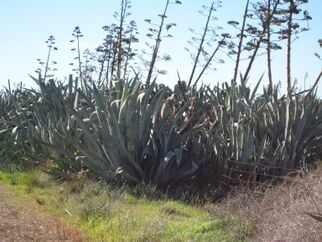
Energy demands worldwide will not be met by fossil fuels alone in the future because there is a limited supply of these fuels, and atmospheric pollution associated with the fossil fuel industry is no longer acceptable. In addition, there is an emerging biofuel industry that will partially offset the need for fossil fuels. Still, there are several unknown environmental and economic consequences associated with land use for bioenergy production. If bioenergy feedstocks can be grown on marginal and semi-arid lands that are not ideal for food crops, there is less risk of indirect land-use change that threatens sensitive ecosystems. Plants that use crassulacean acid metabolism (CAM), including the cacti and Agaves, are of particular interest since they can survive for many months without water. When water is available, they use it with an efficiency that can be more than ten times that of other plants, such as maize, sorghum, miscanthus, and switchgrass. CAM species include no primary current or potential food crops; they have, however, for centuries been cultivated for alcoholic beverages and low-lignin fibers. They may therefore also be ideal for producing biofuels on land unsuited for food production.
In México, active research programs and stakeholders investigate Agave spp. as a bioenergy feedstock. The unique physiology of this genus has been exploited historically for fibers and alcoholic beverages, and there is a wealth of knowledge in the country of México about the life history, genetics, and cultivation of Agave. The State of Jalisco is the denomination of origin of Agave tequilana Weber var. azul, a cultivar primarily used to produce tequila that has been widely researched to optimize yields. Other cultivars of Agave tequilana are grown throughout México, along with the Agave fourcroydes Lem., or henequen, which is an essential source of fiber that has traditionally been used for making ropes. The high sugar content of Agave tequilana may be valuable for liquid fuel production, while the high lignin content of Agave fourcroydes may be valuable for power generation through combustion. Along with the Agave species described above, some economically essential species include A. salmiana, A. angustiana, A. americana, and A. sisalana. Agave sisalana is not produced in México but has been an essential crop in regions of Africa and Australia. Information collected here could thus be relevant to semi-arid areas around the world.
Agave competitive advantages[edit | edit source]
- Thrives on dry land/marginal land. Most efficient use of soil, water, and light.
- Massive production. Year-around harvesting.
- Very high yields with very low or no inputs
- Very high-quality biomass and sugars
- Meager cost of production. Not a commodity, so prices are not volatile
- Very versatile: biofuels, bioproducts, chemicals
- Worldwide geographical distribution
- Enhanced varieties are ready
External Links[edit | edit source]
- Biomass Magazine: Agave might be 'missing energy crop'
- Garbrook knowledge resources: Agave